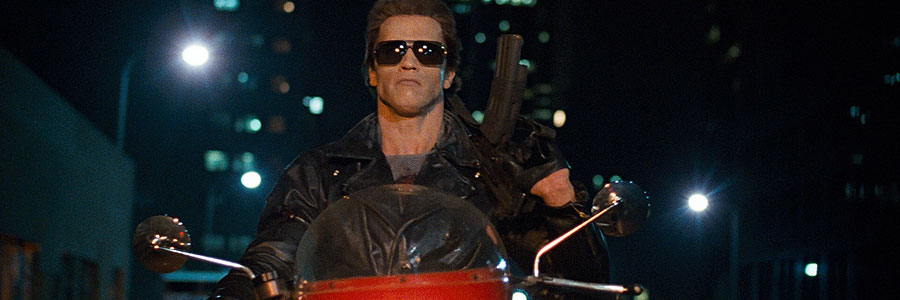
The Terminator

THE TERMINATOR (MOVIE)
Orion Pictures
Original release: October 26th, 1984
Running time: 108 minutes
Director: James Cameron
Writer: James Cameron, Gale Anne Hurd, William Wisher, Jr., Harlan Ellison
Composer: Brad Fiedel
Cast: Arnold Schwarzenegger, Michael Biehn, Linda Hamilton, Lance Henriksen, Paul Winfield
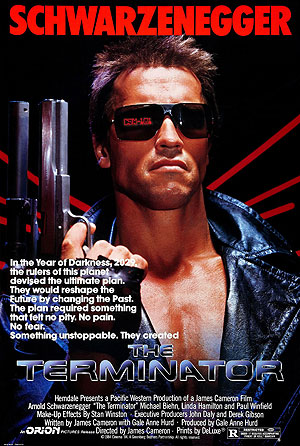
Seeing something utterly familiar in a new light, that’s one of the joys of watching double-bills. At our time travel spectacular last November we’d just finished La jetée, one of cinema’s greatest love stories and it was through teary eyes that I watched the second half of the bill, The Terminator. To my amazement and amusement, this b-movie masterpiece of horror, science fiction and action revealed itself to be a romantic fantasy which reassures the viewer that however unremarkable life feels, fear not, for lurking around the corner is a knight in shining armor/tramp’s clothing about to profess their undying love. It’s basically Mills & Boon with a police station massacre. I also saw other things in there, but let’s start off with the romantic stuff.
Consider the amount of screen time devoted to the relationship between Kyle (Michael Biehn) and Sarah (Linda Hamilton) and the hefty emotional punch it delivers in the final scene. This isn’t mere lust or infatuation, this is worship. Kyle Reece is the soldier from the future sent back to save Sarah Conner from her mundane job, her non-existent love life and the T-800 Terminator hunting her down. When Kyle looks at her he sees only the great person that she will become. And although theirs will be the briefest of encounters, Sarah will dedicate the rest of her life to Kyle’s teachings (Skynet and Judgment Day) and raising the child they create, John Conner, to one day win the war against the machines.
Before we get too starry eyed though, there’s the small fact that Kyle leaves much to be desired as both a romantic lead and an action hero. His method of making contact with Sarah (stalking her like a mentalist tramp…from the future) freaks her out so much she leaves the answer-phone message which leads the T-800 straight to her. Whilst Reece does well to save Sarah in the film’s first two action set-pieces (the Tech Noir shoot out and subsequent car chase), his annoying behaviour soon kicks in. As Frentz & Hocker Rushing note, ‘he lectures her incessantly, never listens to her responses and doubts, demands obedience, and even physically restrains her early attempts to escape from him’. He is then unable to prevent them both from being arrested, once again rendering Sarah a sitting target.
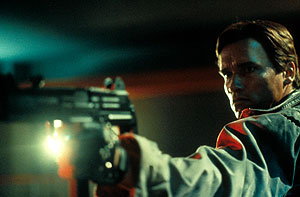
Later in the film, we see that their night of passion was inspired more by pity than animal magnetism. When Reece confesses to Sarah that he traveled across time and space to be with her, he drops the bomb that he’d saved himself just for her. Our hero, the virgin. Sarah is one step ahead though. A few hours earlier she had phoned the T-800, told him exactly where she was and ended the call with…
I love you.
T-800:
I love you too, sweetheart.
You could argue that she thought she was talking to her mother (who the T-800 was imitating having just killed) but this would be doing Sarah a disservice. For she, just like the audience, had long ago worked out that the real star of the show was the T-800 (Arnold Schwarzenegger).
Classically strong and silent, the T-800 knows how to act like an action hero. When he arrives in the 1980s he’s a picture of physical perfection and tranquil as a sculpture (as opposed to Reece’s quivering wreck). At the police station, Reece breaks two key rules of being an action hero – you don’t tell people how brave you are, and if you blab to the police you look like a snitch, a victim or a jabbering loon. When the T-800 has to communicate verbally he does so in short bursts of expletives and demands. When he visits the police station, it’s to kill everybody inside. This is why we all fell in love with him.
As the film progresses, Kyle and Sarah effectively swap roles. Kyle starts talking extensively about his feelings and how he needs to be healed by Sarah’s love, whilst Sarah becomes increasingly disciplined, self-sufficient and aggressive. When Kyle is concussed during the climatic action set-piece, Sarah assumes the role of commanding officer and orders him back into action.
Kyle’s final and most unforgivable failing is dying with the job only half finished. During the final showdown, he blows the T-800 in half with a homemade pipe-bomb but is killed in the blast. Whilst this is a remarkable act of sacrifice, it leaves him looking 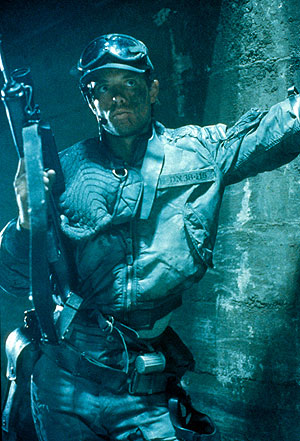 like a klutz hoisted with his own petard. Sarah is struck in the leg by shrapnel from the T-800 but this paradoxically completes her journey from waitress to action hero. Leg wounds are common in action narratives, dating all the way back to ancient mythology, grounding characters as they transform into heroes by ‘slowing (their) incessant movement, deepening (their) connection with the earth, and enhancing (their) capacity for feeling’.
like a klutz hoisted with his own petard. Sarah is struck in the leg by shrapnel from the T-800 but this paradoxically completes her journey from waitress to action hero. Leg wounds are common in action narratives, dating all the way back to ancient mythology, grounding characters as they transform into heroes by ‘slowing (their) incessant movement, deepening (their) connection with the earth, and enhancing (their) capacity for feeling’.
This remarkable transformation of Sarah is only possible with the involvement and input of both Kyle and the T-800. Kyle tells her of her untapped inner strength, starts her training in self-sufficiency and guerrilla warfare, and, of course, is the father of John Conner. During that eye-opening viewing of The Terminator though, it struck me that Sarah is also penetrated and forever changed by the T-800.
The piece of the Terminator which enters Sarah’s leg is unmistakably phallic, and by ceaselessly trying to kill Sarah, the T-800 teaches her what she must be prepared to do in order to fulfill her destiny. When we see her eleven years later (in Terminator 2: Judgment Day) she has become a muscular warrior determined not to allow pity or fear cloud her judgment. When she attempts to kill Miles Dyson (the inventor of the neural-net processor which leads to the development of Skynet), she is more Terminator than human.
All of these revelations made that peculiar screening an enlightening experience but over the next few months my thoughts kept returning to the question, is there even more going on here?
My starting point was the suspicion that the love triangle at the core of the film was even more encompassing and the codes and conventions of Classical Hollywood provided the most compelling evidence. Back when homosexuality and its representation on screen were prohibited  by US law and the Hayes Code (respectively), the sure fire way to establish a gay subtext between two male characters was for them to share a female character, sexually. This has continued long after the Hayes code was abandoned and can often be found in Film Noir, Westerns and all the way up to the hypermasculine action films of the 1980s, The Terminator being arguably the definitive example.
by US law and the Hayes Code (respectively), the sure fire way to establish a gay subtext between two male characters was for them to share a female character, sexually. This has continued long after the Hayes code was abandoned and can often be found in Film Noir, Westerns and all the way up to the hypermasculine action films of the 1980s, The Terminator being arguably the definitive example.
Despite a mutual obsession, there isn’t a great deal more to suggest that Kyle and the T-800 were trying to do more than just destroy each other. This line of investigation did lead me toward the fact that, despite being produced during a notoriously conservative era in American history, 80s action cinema positively crackled with homoeroticism.
The first iconic image of The Terminator is of a naked Arnold Schwarzenegger, an image which will be recycled for the next two sequels but as the ravages of time took their toll, Arnie’s physique would never again be so monstrously musculature. Arriving in Los Angeles in the nip, the T-800 had ripped out a punk’s heart out, ordered another to strip and surveyed the sprawl of his battle-ground to be before he’s donned so much as a pair of underpants. Such displays were common in 80s action cinema in which ‘visual pleasures focused on the display of the male body’ were offered to film-goers, generating millions of dollars by reconfiguring and redeploying homoerotic imagery for mass-consumption.
It’s hardly surprising that many of the action stars became gay icons but whilst some, such as Jean-Claude Van Damme, embraced this status, Arnie would instead claim that he has only ever been an icon for all sexual orientations. This denial may be rooted in his upbringing in 1950s Austria. When, as a teenager, he discovered the world of body-building and covered his walls 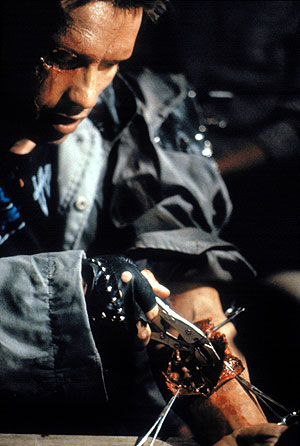 with posters of oiled up men, his father beat him and his mother contacted a doctor fearing that he was ‘turning south’. By the third film of the Terminator franchise, Rise of the Machines, the naked Arnie goes in search of clothes and transport in a gay night club and, hilariously, is mistaken for a male stripper upon arrival. In doing so, the film can be read as having fun with the notion of the T-800/Arnie as a gay icon.
with posters of oiled up men, his father beat him and his mother contacted a doctor fearing that he was ‘turning south’. By the third film of the Terminator franchise, Rise of the Machines, the naked Arnie goes in search of clothes and transport in a gay night club and, hilariously, is mistaken for a male stripper upon arrival. In doing so, the film can be read as having fun with the notion of the T-800/Arnie as a gay icon.
Others saw something far more sinister coded within the image of the T-800. The horror genre has historically resonated with sexual tension and been pre-occupied with sexual difference. In his celebrated study of American horror films, Robin Wood stated that monsters are primarily constructed as sexual Others, operating in opposition to the status quo and representing all that is repressed. As the monster in sci-fi/action/horror film, the T-800 can be read as an allegory for closeted homosexuality, which had been linked by neo-conservatives and the religious ‘moral majority’ to sexual depravity, paedophilia and the spread of AIDS, forces which they claimed were eroding communities and destroying ‘traditional’ family values. Geven notes that due to the T-800?s combination of flesh and steel, it is “able to pass as human but containing within him a secret identity destructive to human life” before labeling it an unstable and challenging metaphor for queer people.
In contrast, queer and feminist theory found far more positive connotations in the concept of the cyborg, who, by rejecting the rigid boundaries of ‘human’ and ‘machine’, allow their identity to be fluid and unfixed. For all of Sarah’s masculinisation and liberation, her primary role as vessel and guardian for the great John Conner is still determined by her gender. For the cyborg, gender is no longer aligned with reproductive roles and what is internal is no longer tied to the flesh.
This places The Terminator within a wider context of science fiction primarily concerned with the process of reproduction, which stretches from Frankenstein, first published almost two hundred years ago, through Invasion of the Body Snatchers, 2001: A Space Odyssey, the Alien franchise, Blade Runner, Gattica, Children of Men and Moon, to name a few.
The conclusion of The Terminator can be seen as a battle between modes of reproduction – Sarah, the biological mother of John Conner, versus the T-800, the enemy of human reproductivity, designed, developed and assembled by Skynet in automated factories. 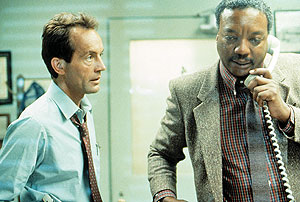 After a long chase in which the T-800?s clothes and flesh are burnt away, revealing its steel chassis, the final battle takes place in a factory/manufacturing area – a place of exposed steel, wiring and pipes – home turf (and spiritual birth place) for the T-800. After vein attempts to hide amongst the automated machinery and computer terminals, Kyle and Sarah must face the T-800 head on.
After a long chase in which the T-800?s clothes and flesh are burnt away, revealing its steel chassis, the final battle takes place in a factory/manufacturing area – a place of exposed steel, wiring and pipes – home turf (and spiritual birth place) for the T-800. After vein attempts to hide amongst the automated machinery and computer terminals, Kyle and Sarah must face the T-800 head on.
It’s worth noting that both Reece’s and Sarah’s last words to the T-800 are loaded with reproductive connotations. Reece calls it a mother fucker just before attacking it with an iron bar, and as already mentioned, the T-800 does (in a sense) penetrate the human mother in the explosion which comes shortly after Reece’s line.
Sarah, using herself as bait to entice it into a hydraulic press, famously informs the T-800 ‘you’re terminated, fucker’ before crushing it between the stamping plates. For the sake of this reading, the press can be seen as womb-like which gives Sarah’s pay-off line connotations of abortion. The T-800 is killed within the mechanical womb and yet this victory is only fleeting and does nothing to prevent the coming apocalypse.
Fate has determined that the factory which in which the climactic battle takes place is owned by defense firm Cyberdine Systems who would build Skynet, the global defense network of autonomous military hardware which would eventually produce the Terminators. This is no wild coincidence. In a deleted scene from the end of The Terminator, we see Cyberdine staff sneak remnants of the destroyed T-800 off of the crime scene and comment on its advanced nature. In Terminator 2 we discover that they only make major breakthroughs which enable them to create Skynet by reverse engineering these remains.
Paradoxically, Sarah’s destruction of the T-800 was essential in the creation of Skynet, and the factory represents the birth place of the Terminators and the automated assembly plants which produced them. This places Sarah in the remarkable position of mother of the rebellion and an architect of Judgment Day. But that’s what you get for getting intimate with both sides.
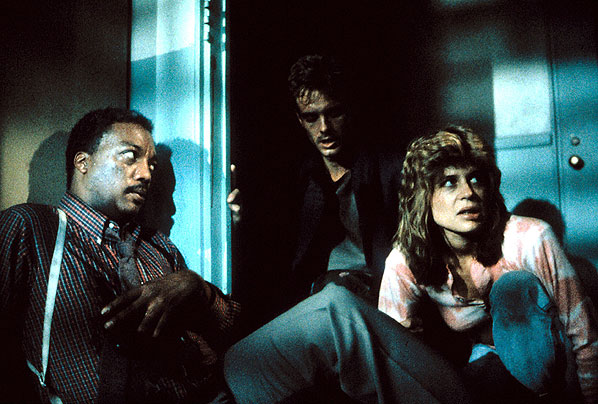

Ian Roberts
After spending the last ten years playing in bands and promoting electronica nights in Winchester (Hampshire, UK), Ian combined his love of film and music by co-founding SuperCool Cinema, a pop-up cinema specialising in live soundtracking and double-bills of cult classics old and new.
SuperCool cinema’s modestly sized film blog has also enabled him to carry on writing since completing his Master of Arts in Film Studies, highlights of which include his epic thesis on 21st Century revenge cinema and leading a group reading of the opening twenty minutes of David Lynch’s Inland Empire.
Put a gun to his head and demand to know his favourite three films and he would say 2001: A Space Odyssey, Robocop and Fargo but then follow you around saying that he was maybe considering swapping Fargo for The Fly or Notorious until you got your gun out again.
You can follow Ian on Twitter at @SuperCoolCinema and on Facebook.
© 2022 STATIC MASS EMPORIUM . All Rights Reserved. Powered by METATEMPUS | creative.timeless.personal. | DISCLAIMER, TERMS & CONDITIONS
HOME | ABOUT | CONTACT | TWITTER | GOOGLE+ | FACEBOOK | TUMBLR | YOUTUBE | RSS FEED
CINEMA REVIEWS | BLU-RAY & DVD | THE EMPORIUM | DOCUMENTARIES | WORLD CINEMA | CULT MOVIES | INDIAN CINEMA | EARLY CINEMA
MOVIE CLASSICS | DECONSTRUCTING CINEMA | SOUNDTRACKS | INTERVIEWS | THE DIRECTOR’S CHAIR | JAPANESE CINEMA





